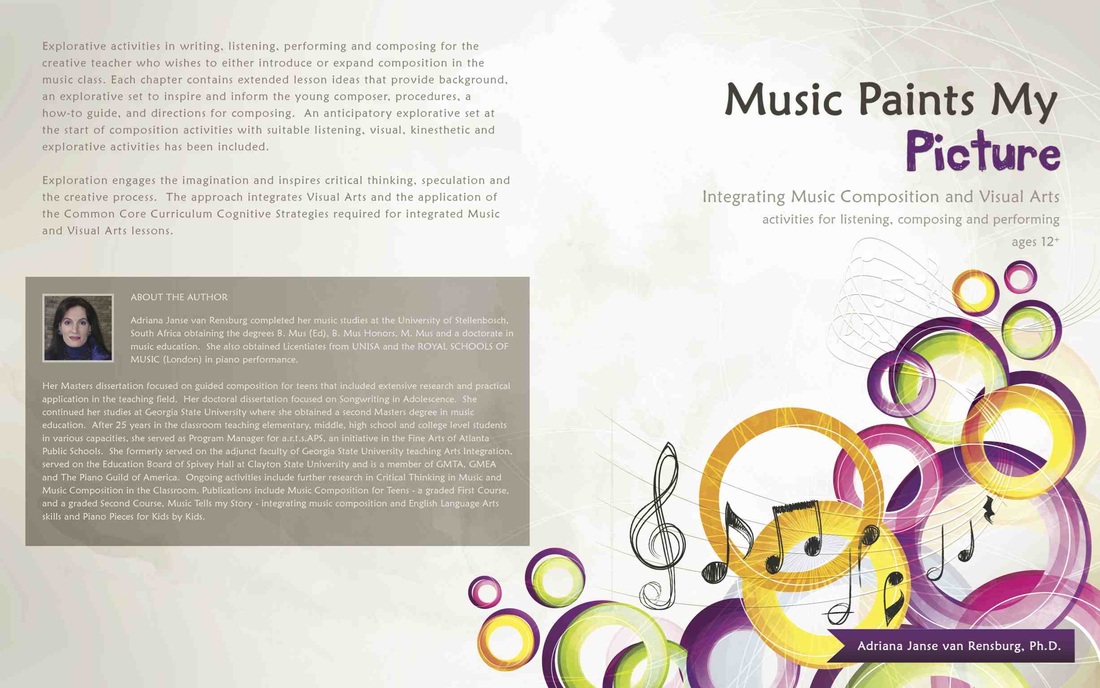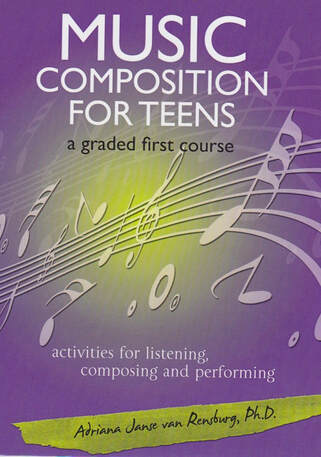
MUSIC COMPOSITION FOR TEENS -A GRADED FIRST COURSE
This book contains explorative activities in listening, composing and performing for the creative teacher who wishes to either introduce or expand composition in the music class. It is a graded course ranging from the simplest of rhythmic and pitch activities to more advanced work on triads, four-part writing and 20th century techniques. Each chapter contains extended lesson ideas that provide background, explorative ideas to inspire and inform the young composer, and directions for composing. Exploration engages the imagination and inspires critical thinking, speculation, and the creative process. This is also a multimedia course that uses keyboards, instruments, video, recording devices, computers, notation software and other media. It is aimed at encouraging student interactivity with various media. It is also a multi-arts course as visual, dramatic and language arts are included where applicable. The course includes music from various cultures and this multi-cultural approach allows students to develop a deeper understanding of various tone systems, instruments and musical approaches used across the world. Assignments focus on structured creativity which guides students to symbolize sound through guided composition activities, thus enabling students to acquire a musical literacy. This composition course is neither a theory nor a harmony method, but rather a composition skill and knowledge builder. Teachers may supplement composition assignments with more detailed theory and harmony if necessary. This course is aimed at the acquisition of standard notation skills. In addition there is an introduction to the use of improvisation, electronic media and twentieth-century techniques employing graphic notation. The first composition assignments begin with simple four measure phrases. The assignments become more challenging as the course progresses. Compositions need not be enormous works of many pages. Indeed, shorter compositions which accurately demonstrate a compositional device will be far more worthwhile and less daunting to the beginner composer. Any of the composition assignments can be expanded if necessary. Even the simplest four measure structure can be expanded to a lengthy composition by using the devices learned in the module. Teachers should engage students through and anticipatory explorative set at the start of composition activities with suitable listening, visual, kinesthetic and explorative activities. Exploration engages the imagination and inspires critical thinking, speculation and the creative process. Suggestions have been included where applicable. Listening suggestions include more well-know works easily accessible in the media. A wide variety of musical styles is addressed and explored in this course. Teachers should use discretion, not all assignments would be suitable for your particular group. However, by exploring many musical styles e.g. jazz, African music, modes, Boogies, etc. the idea remains that Composing and creative activities are for skill building and application; Knowledge regarding various musical styles and cultures should be gained through active, creative exploration; Various styles and compositional techniques should be learned, not to stereotype student compositions, but to broaden the young musician’s scope and horizons. Photocopiable material is included.
https://www.amazon.com/Music-Composition-Teens-graded-course/dp/1484196902
This book contains explorative activities in listening, composing and performing for the creative teacher who wishes to either introduce or expand composition in the music class. It is a graded course ranging from the simplest of rhythmic and pitch activities to more advanced work on triads, four-part writing and 20th century techniques. Each chapter contains extended lesson ideas that provide background, explorative ideas to inspire and inform the young composer, and directions for composing. Exploration engages the imagination and inspires critical thinking, speculation, and the creative process. This is also a multimedia course that uses keyboards, instruments, video, recording devices, computers, notation software and other media. It is aimed at encouraging student interactivity with various media. It is also a multi-arts course as visual, dramatic and language arts are included where applicable. The course includes music from various cultures and this multi-cultural approach allows students to develop a deeper understanding of various tone systems, instruments and musical approaches used across the world. Assignments focus on structured creativity which guides students to symbolize sound through guided composition activities, thus enabling students to acquire a musical literacy. This composition course is neither a theory nor a harmony method, but rather a composition skill and knowledge builder. Teachers may supplement composition assignments with more detailed theory and harmony if necessary. This course is aimed at the acquisition of standard notation skills. In addition there is an introduction to the use of improvisation, electronic media and twentieth-century techniques employing graphic notation. The first composition assignments begin with simple four measure phrases. The assignments become more challenging as the course progresses. Compositions need not be enormous works of many pages. Indeed, shorter compositions which accurately demonstrate a compositional device will be far more worthwhile and less daunting to the beginner composer. Any of the composition assignments can be expanded if necessary. Even the simplest four measure structure can be expanded to a lengthy composition by using the devices learned in the module. Teachers should engage students through and anticipatory explorative set at the start of composition activities with suitable listening, visual, kinesthetic and explorative activities. Exploration engages the imagination and inspires critical thinking, speculation and the creative process. Suggestions have been included where applicable. Listening suggestions include more well-know works easily accessible in the media. A wide variety of musical styles is addressed and explored in this course. Teachers should use discretion, not all assignments would be suitable for your particular group. However, by exploring many musical styles e.g. jazz, African music, modes, Boogies, etc. the idea remains that Composing and creative activities are for skill building and application; Knowledge regarding various musical styles and cultures should be gained through active, creative exploration; Various styles and compositional techniques should be learned, not to stereotype student compositions, but to broaden the young musician’s scope and horizons. Photocopiable material is included.
https://www.amazon.com/Music-Composition-Teens-graded-course/dp/1484196902
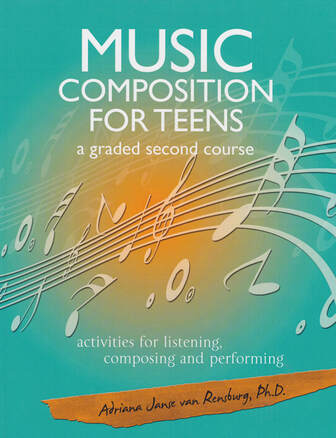
MUSIC COMPOSITION FOR TEENS -A GRADED SECOND COURSE
This book is written as an aid for the creative teacher who wishes to expand composition in the music class. It is a graded course, following on Music Composition for Teens - a graded First Course. Activities include assignments on more advanced work including triads, secondary triads, four-part writing and twentieth-century techniques. This is also a multimedia course that uses keyboards, instruments, video, recording devices, computers, notation software and other media. It is aimed at encouraging student interactivity with various media. It is also a multi-arts course as visual, dramatic and language arts are included where applicable. The course includes music from various cultures and this multi-cultural approach allows students to develop a deeper understanding of various tone systems, instruments and musical approaches used across the world. Assignments focus on structured creativity which guides students to symbolize sound through guided composition activities, thus enabling students to acquire a musical literacy. This composition course is neither a theory nor a harmony method, but rather a composition skill and knowledge builder. Teachers may supplement composition assignments with more detailed theory and harmony work. This course is aimed at the acquisition of standard notation skills. In addition there is an introduction to the use of improvisation, electronic media and twentieth-century techniques employing graphic notation. Composition assignments begin with simple two or four measure phrases exploring new concepts. The assignments become more challenging as the course progresses. Compositions need not be enormous works of many pages. Indeed, shorter compositions which accurately demonstrate a compositional device will be far more worthwhile and less daunting to the beginner composer. Any of the composition assignments can be expanded if necessary. Even the simplest four measure structure can be expanded to a lengthy composition by using the devices learned in the module. Teachers should engage students through an anticipatory explorative set at the start of composition activities with suitable listening, visual, kinesthetic and explorative activities. Exploration engages the imagination and inspires critical thinking, speculation and the creative process. Suggestions have been included where applicable. Listening suggestions include more well-known works easily accessible in the media. A wide variety of musical styles is addressed and explored in this course. Teachers should use discretion, not all assignments would be suitable for your particular group. However, by exploring many musical styles e.g. jazz, African music, Baroque, ensemble, etc. the idea remains that Composing and creative activities are for skill building and application; Knowledge regarding various musical styles and cultures should be gained through active, creative exploration; Various styles and compositional techniques should be learned, not to stereotype student compositions, but to broaden the young musician’s scope and horizons.
https://www.amazon.com/Music-Composition-Teens-activities-performing/dp/1499697139/ref=pd_bxgy_img_1/130-0818455-9628332?pd_rd_w=dc6zY&pf_rd_p=6b3eefea-7b16-43e9-bc45-2e332cbf99da&pf_rd_r=058J0YC7C7NJNABQVYZ5&pd_rd_r=5e30a71d-fa06-45f5-8f65-fda857e50e08&pd_rd_wg=SOPIM&pd_rd_i=1499697139&psc=1
This book is written as an aid for the creative teacher who wishes to expand composition in the music class. It is a graded course, following on Music Composition for Teens - a graded First Course. Activities include assignments on more advanced work including triads, secondary triads, four-part writing and twentieth-century techniques. This is also a multimedia course that uses keyboards, instruments, video, recording devices, computers, notation software and other media. It is aimed at encouraging student interactivity with various media. It is also a multi-arts course as visual, dramatic and language arts are included where applicable. The course includes music from various cultures and this multi-cultural approach allows students to develop a deeper understanding of various tone systems, instruments and musical approaches used across the world. Assignments focus on structured creativity which guides students to symbolize sound through guided composition activities, thus enabling students to acquire a musical literacy. This composition course is neither a theory nor a harmony method, but rather a composition skill and knowledge builder. Teachers may supplement composition assignments with more detailed theory and harmony work. This course is aimed at the acquisition of standard notation skills. In addition there is an introduction to the use of improvisation, electronic media and twentieth-century techniques employing graphic notation. Composition assignments begin with simple two or four measure phrases exploring new concepts. The assignments become more challenging as the course progresses. Compositions need not be enormous works of many pages. Indeed, shorter compositions which accurately demonstrate a compositional device will be far more worthwhile and less daunting to the beginner composer. Any of the composition assignments can be expanded if necessary. Even the simplest four measure structure can be expanded to a lengthy composition by using the devices learned in the module. Teachers should engage students through an anticipatory explorative set at the start of composition activities with suitable listening, visual, kinesthetic and explorative activities. Exploration engages the imagination and inspires critical thinking, speculation and the creative process. Suggestions have been included where applicable. Listening suggestions include more well-known works easily accessible in the media. A wide variety of musical styles is addressed and explored in this course. Teachers should use discretion, not all assignments would be suitable for your particular group. However, by exploring many musical styles e.g. jazz, African music, Baroque, ensemble, etc. the idea remains that Composing and creative activities are for skill building and application; Knowledge regarding various musical styles and cultures should be gained through active, creative exploration; Various styles and compositional techniques should be learned, not to stereotype student compositions, but to broaden the young musician’s scope and horizons.
https://www.amazon.com/Music-Composition-Teens-activities-performing/dp/1499697139/ref=pd_bxgy_img_1/130-0818455-9628332?pd_rd_w=dc6zY&pf_rd_p=6b3eefea-7b16-43e9-bc45-2e332cbf99da&pf_rd_r=058J0YC7C7NJNABQVYZ5&pd_rd_r=5e30a71d-fa06-45f5-8f65-fda857e50e08&pd_rd_wg=SOPIM&pd_rd_i=1499697139&psc=1
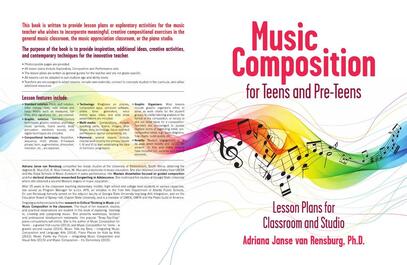
MUSIC COMPOSITION FOR TEENS AND PRE-TEENS
LESSON PLANS FOR CLASSROOM AND STUDIO
This book is written to provide lesson plans or exploratory activities for the music teacher who wishes to incorporate meaningful, creative compositional exercises in the general music classroom, the music appreciation classroom, or the piano studio. The purpose of the book is to provide inspiration, additional ideas, creative activities, and contemporary techniques for the innovative teacher. Photocopiable pages are provided. All lesson plans include Exploratory, Composition and Performance sets. The lesson plans are written as general guides for the teacher and are not grade specific. All lessons can be adapted to suit multiple age and ability levels. Teachers are encouraged to adapt lessons: include own materials, connect to concepts studied in the curricula, and utilize additional resources. Lesson features include Standard notation: pitch, staff notation, letter names, rests, note values and basic theory such as measures, bar lines, time signatures, etc., are covered. Graphic notation: Twentieth-Century techniques, graphic notation, alternative music symbols, found sound, body percussion, electronic sounds, and digital techniques are included. Compositional techniques: repetition, sequence, motif, phrase, 4-measure phrase, form, augmentation, diminution, inversion, etc., are explored. Technology: ringtones on phones, composition apps, computer software, online tone- generators, voice memo apps, video, and slide show presentations are included. Multi-media: Compositions include speaking parts, drama, images, slide shows, story, technology, live or recorded performance, spatial components, etc. Harmony: several lessons include chordal work (mainly the primary chords I, IV and V) to start establishing the idea of harmonic progression. Graphic Organizers: Most lessons include graphic organizers either to serve as work charts for the student groups, to clarify listening analysis or the format of the composition, or simply to plot out initial ideas for a composition. Teachers are encouraged to pursue multiple forms of organizing initial, pre-composition ideas, e.g., Venn-diagrams, flow charts, bullet points, etc. Novelty: Student engagement is at its peak when novelty and variety are present. To this end many lessons have included fun, surprise and novelty elements.
https://www.amazon.com/Music-Composition-Teens-Pre-Teens-Performing/dp/1717461719/ref=sr_1_3?crid=3UCDG5SS66RDU&keywords=MUSIC+COMPOSITION+FOR+TEENS&qid=1645212611&s=books&sprefix=music+composition+for+teens%2Cstripbooks%2C94&sr=1-3
LESSON PLANS FOR CLASSROOM AND STUDIO
This book is written to provide lesson plans or exploratory activities for the music teacher who wishes to incorporate meaningful, creative compositional exercises in the general music classroom, the music appreciation classroom, or the piano studio. The purpose of the book is to provide inspiration, additional ideas, creative activities, and contemporary techniques for the innovative teacher. Photocopiable pages are provided. All lesson plans include Exploratory, Composition and Performance sets. The lesson plans are written as general guides for the teacher and are not grade specific. All lessons can be adapted to suit multiple age and ability levels. Teachers are encouraged to adapt lessons: include own materials, connect to concepts studied in the curricula, and utilize additional resources. Lesson features include Standard notation: pitch, staff notation, letter names, rests, note values and basic theory such as measures, bar lines, time signatures, etc., are covered. Graphic notation: Twentieth-Century techniques, graphic notation, alternative music symbols, found sound, body percussion, electronic sounds, and digital techniques are included. Compositional techniques: repetition, sequence, motif, phrase, 4-measure phrase, form, augmentation, diminution, inversion, etc., are explored. Technology: ringtones on phones, composition apps, computer software, online tone- generators, voice memo apps, video, and slide show presentations are included. Multi-media: Compositions include speaking parts, drama, images, slide shows, story, technology, live or recorded performance, spatial components, etc. Harmony: several lessons include chordal work (mainly the primary chords I, IV and V) to start establishing the idea of harmonic progression. Graphic Organizers: Most lessons include graphic organizers either to serve as work charts for the student groups, to clarify listening analysis or the format of the composition, or simply to plot out initial ideas for a composition. Teachers are encouraged to pursue multiple forms of organizing initial, pre-composition ideas, e.g., Venn-diagrams, flow charts, bullet points, etc. Novelty: Student engagement is at its peak when novelty and variety are present. To this end many lessons have included fun, surprise and novelty elements.
https://www.amazon.com/Music-Composition-Teens-Pre-Teens-Performing/dp/1717461719/ref=sr_1_3?crid=3UCDG5SS66RDU&keywords=MUSIC+COMPOSITION+FOR+TEENS&qid=1645212611&s=books&sprefix=music+composition+for+teens%2Cstripbooks%2C94&sr=1-3
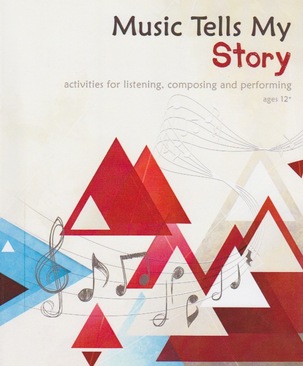
Music Tells My Story
integrating music composition and English Language Arts skills.
ISBN 9781491239568
$24.99
amazon.com
integrating music composition and English Language Arts skills.
- Explorative activities in writing, listening, performing and composing.
- Each chapter contains extended lesson ideas that provide background, an explorative set to inspire and inform the young composer, procedures, a how-to guide, and directions for composing.
- An anticipatory explorative set at the start of composition activities with suitable listening, visual, kinesthetic and explorative activities has been included. Exploration engages the imagination and inspires critical thinking, speculation and the creative process. This book integrates music composition and English Language Arts and the application of the Common Core Curriculum Cognitive Strategies required for integrated Music and English Language Arts lessons. Photocopiable material included.
ISBN 9781491239568
$24.99
amazon.com
Music Paints My Picture -integrating music composition and visual arts- Explorative activities in writing, listening, performing and composing.
- Each chapter contains extended lesson ideas that provide background, an explorative set to inspire and inform the young composer, procedures, a how-to guide, and directions for composing.
- An anticipatory explorative set at the start of composition activities with suitable listening, visual, kinesthetic and explorative activities has been included. Exploration engages the imagination and inspires critical thinking, speculation and the creative process.
- This book integrates music composition and Visual Arts and the application of the Common Core Curriculum Cognitive Strategies required for integrated Music and Visual Arts lessons. Photocopiable material included.
ISBN-13: 978-1505361865
ISBN-10: 1505361869
$24.99
amazon.com
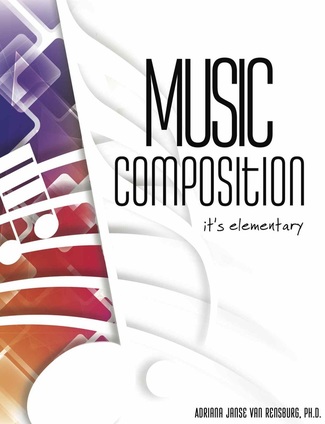
MUSIC COMPOSITION - IT'S ELEMENTARY
for late elementary and middle school
This book provides lesson plans and exploratory activities for the elementary or middle school music teacher who wishes to incorporate meaningful, creative compositional activities in the general music classroom. This book aims to provide inspiration, additional ideas, creative activities, and contemporary techniques for the innovative teacher. All lesson plans include an Exploratory Set, a step-by-step Composition Guide, photocopiable templates, and Performance suggestions. The lesson plans are written as a general guide for the teacher and are not grade specific. All lessons can be adapted to suit multiple age and ability levels. Flexible composition lesson plans allow teachers to include own materials, connect to concepts studied in the curricula, and utilize additional resources. Photocopiable pages have been provided. Lesson features include: Standard notation: pitch, staff notation, letter names, rests, note values and basic theory such as measures, bar lines, time signatures, etc. Graphic notation: twentieth-century techniques, graphic notation, alternative music symbols, found sounds, body percussion, electronic sounds, and digital techniques Compositional techniques: repetition, sequence, motif, phrase, 4-measure phrase, form, augmentation, diminution, inversion, etc. Technology: ringtones on phones, composition apps, computer software, online tone-generators, voice memo apps, video, and slide show presentations Multi-media: Compositions include speaking parts, drama, images, slide shows, story, technology, live or recorded performance, spatial components, etc. Harmony: chordal work to start establishing the idea of harmonic progression Graphic Organizers: work charts for student groups, listening analysis, format of the composition, brainstorm maps, etc. Novelty: Student engagement is at its peak when novelty and variety are present. To this end many lessons have included fun, surprise and novelty items such as games, cards, toys, pipes, string, buttons, dominoes, images, charts, new sounds, etc.
for late elementary and middle school
- ISBN-10: 1511628561
- ISBN-13: 978-1511628563
- $29.99
- amazon.com
This book provides lesson plans and exploratory activities for the elementary or middle school music teacher who wishes to incorporate meaningful, creative compositional activities in the general music classroom. This book aims to provide inspiration, additional ideas, creative activities, and contemporary techniques for the innovative teacher. All lesson plans include an Exploratory Set, a step-by-step Composition Guide, photocopiable templates, and Performance suggestions. The lesson plans are written as a general guide for the teacher and are not grade specific. All lessons can be adapted to suit multiple age and ability levels. Flexible composition lesson plans allow teachers to include own materials, connect to concepts studied in the curricula, and utilize additional resources. Photocopiable pages have been provided. Lesson features include: Standard notation: pitch, staff notation, letter names, rests, note values and basic theory such as measures, bar lines, time signatures, etc. Graphic notation: twentieth-century techniques, graphic notation, alternative music symbols, found sounds, body percussion, electronic sounds, and digital techniques Compositional techniques: repetition, sequence, motif, phrase, 4-measure phrase, form, augmentation, diminution, inversion, etc. Technology: ringtones on phones, composition apps, computer software, online tone-generators, voice memo apps, video, and slide show presentations Multi-media: Compositions include speaking parts, drama, images, slide shows, story, technology, live or recorded performance, spatial components, etc. Harmony: chordal work to start establishing the idea of harmonic progression Graphic Organizers: work charts for student groups, listening analysis, format of the composition, brainstorm maps, etc. Novelty: Student engagement is at its peak when novelty and variety are present. To this end many lessons have included fun, surprise and novelty items such as games, cards, toys, pipes, string, buttons, dominoes, images, charts, new sounds, etc.
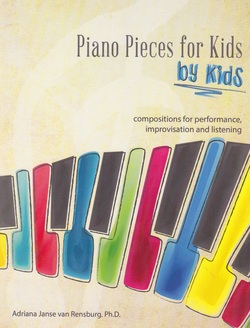
PIANO PIECES FOR KIDS BY KIDS
The piano pieces composed by the under 10 year old piano students include explorative activities in listening, performing and improvising for the creative teacher who wishes to either introduce or expand composition in the piano lesson. Each piece contains lesson ideas, accompaniments, and ideas for the piano teacher in performing and improvising.
ISBN N9781494211578
$19.99
amazon.com
The piano pieces composed by the under 10 year old piano students include explorative activities in listening, performing and improvising for the creative teacher who wishes to either introduce or expand composition in the piano lesson. Each piece contains lesson ideas, accompaniments, and ideas for the piano teacher in performing and improvising.
ISBN N9781494211578
$19.99
amazon.com
